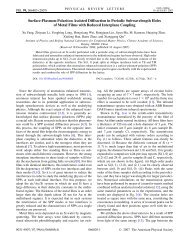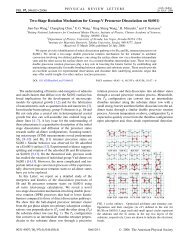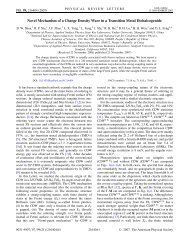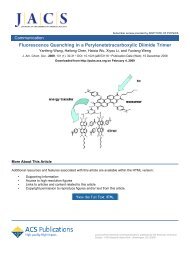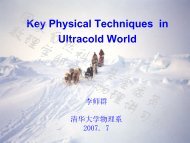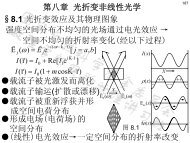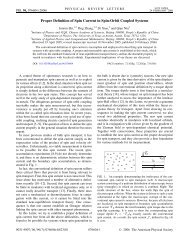Quantum Anomalous Hall Effect in Hg 1-y Mn y Te QuantumWells
Quantum Anomalous Hall Effect in Hg 1-y Mn y Te QuantumWells
Quantum Anomalous Hall Effect in Hg 1-y Mn y Te QuantumWells
Create successful ePaper yourself
Turn your PDF publications into a flip-book with our unique Google optimized e-Paper software.
PRL 101, 146802 (2008) PHYSICAL REVIEW LETTERS<br />
<strong>Quantum</strong> <strong>Anomalous</strong> <strong>Hall</strong> <strong>Effect</strong> <strong>in</strong> <strong>Hg</strong> 1 y<strong>Mn</strong> y<strong>Te</strong> <strong>Quantum</strong> Wells<br />
Chao-X<strong>in</strong>g Liu, 1,2 Xiao-Liang Qi, 2 Xi Dai, 3 Zhong Fang, 3 and Shou-Cheng Zhang 2<br />
1<br />
Center for Advanced Study, Ts<strong>in</strong>ghua University, Beij<strong>in</strong>g, 100084, Ch<strong>in</strong>a<br />
2<br />
Department of Physics, McCullough Build<strong>in</strong>g, Stanford University, Stanford, California 94305-4045, USA<br />
3<br />
Institute of Physics, Ch<strong>in</strong>ese Academy of Sciences, Beij<strong>in</strong>g, 100080, Ch<strong>in</strong>a<br />
(Received 20 February 2008; published 1 October 2008)<br />
The quantum <strong>Hall</strong> effect is usually observed when a two-dimensional electron gas is subjected to an<br />
external magnetic field, so that their quantum states form Landau levels. In this work we predict that a new<br />
phenomenon, the quantum anomalous <strong>Hall</strong> effect, can be realized <strong>in</strong> <strong>Hg</strong>1 y<strong>Mn</strong>y<strong>Te</strong> quantum wells, without<br />
an external magnetic field and the associated Landau levels. This effect arises purely from the sp<strong>in</strong><br />
polarization of the <strong>Mn</strong> atoms, and the quantized <strong>Hall</strong> conductance is predicted for a range of quantum well<br />
thickness and the concentration of the <strong>Mn</strong> atoms. This effect enables dissipationless charge current <strong>in</strong><br />
sp<strong>in</strong>tronics devices.<br />
DOI: 10.1103/PhysRevLett.101.146802 PACS numbers: 73.43. f, 72.25.Dc, 75.50.Pp, 85.75. d<br />
When a two-dimensional electron gas is subjected to a<br />
high magnetic field, electronic states form Landau levels.<br />
When the temperature is low compared to the spac<strong>in</strong>g<br />
between Landau levels, quantized <strong>Hall</strong> conductance can<br />
be observed. In the quantum <strong>Hall</strong> (QH) regime, electric<br />
current flows unidirectionally along the edge of the sample<br />
without any dissipation due to the absence of backscatter<strong>in</strong>g.<br />
The break<strong>in</strong>g of time reversal symmetry (TRS) is a<br />
necessary condition for the <strong>Hall</strong> effect; however, an external<br />
magnetic field (MF) is not required. Soon after the<br />
observation of the <strong>Hall</strong> effect, <strong>Hall</strong> also observed the<br />
anomalous <strong>Hall</strong> effect [1], where an additional <strong>Hall</strong> resistance<br />
arises from the sp<strong>in</strong>-orbit <strong>in</strong>teraction between electric<br />
current and magnetic moments. In the extreme case, an<br />
anomalous <strong>Hall</strong> effect can occur without the external MF<br />
as long as the system breaks TRS spontaneously. Given the<br />
experimental observation of the QH effect, it is natural to<br />
ask whether the anomalous <strong>Hall</strong> effect can also be quantized<br />
without external MF and the associated Landau levels.<br />
Such a question is not only of great academic <strong>in</strong>terest,<br />
but also has important practical implications. Realiz<strong>in</strong>g<br />
dissipationless charge current through the quantum anomalous<br />
<strong>Hall</strong> (QAH) effect without an external MF could<br />
enable a new generation of quantum electronic devices.<br />
Some years ago, Haldane [2] constructed a theoretical<br />
toy model <strong>in</strong> the honeycomb lattice to show that QH effect<br />
is <strong>in</strong> pr<strong>in</strong>ciple possible without Landau levels. This model<br />
breaks TRS but conserves lattice translation symmetry.<br />
Haldane’s model was extended to <strong>in</strong>clude localization<br />
physics <strong>in</strong> Ref. [3]. Unfortunately, this model is mostly<br />
academic, and cannot be realized <strong>in</strong> the recently discovered<br />
graphene system. Later, the work on the <strong>in</strong>tr<strong>in</strong>sic anomalous<br />
<strong>Hall</strong> effect of a ferromagnetic semiconductor <strong>in</strong> a<br />
metallic regime [4–6] showed the relation between<br />
Berry’s phase and <strong>Hall</strong> conductance. Qi et al. [7] constructed<br />
a tight-b<strong>in</strong>d<strong>in</strong>g model of electron sp<strong>in</strong>-orbit<br />
coupled to the polarized magnetic moments, and showed<br />
that <strong>Hall</strong> conductance can be quantized <strong>in</strong> appropriate<br />
week end<strong>in</strong>g<br />
3 OCTOBER 2008<br />
parameter regimes. This model breaks TRS due to magnetic<br />
moments rather than Landau levels, and provides<br />
another example of the QAH effect. More recently, a<br />
closely related topological phenomenon known as the<br />
quantum sp<strong>in</strong> <strong>Hall</strong> (QSH) effect has been theoretically<br />
predicted and experimentally observed <strong>in</strong> <strong>Hg</strong><strong>Te</strong> quantum<br />
wells (QW) [8,9]. In this work, we show that when the<br />
<strong>Hg</strong><strong>Te</strong> QW are doped with magnetic <strong>Mn</strong> atoms, the QAH<br />
effect can be realized with<strong>in</strong> an experimentally accessible<br />
parameter regime. We propose an experiment to demonstrate<br />
that the quantized <strong>Hall</strong> conductance <strong>in</strong>deed arises<br />
from magnetic moments rather than Landau levels.<br />
As a start<strong>in</strong>g po<strong>in</strong>t, we first briefly review the physics of<br />
the QSH effect <strong>in</strong> <strong>Hg</strong><strong>Te</strong> QW. <strong>Hg</strong><strong>Te</strong> has an <strong>in</strong>verted band<br />
structure, where the p-type 8 band has higher energy<br />
compared to the s-type 6 band at the po<strong>in</strong>t. For<br />
<strong>Hg</strong><strong>Te</strong>=Cd<strong>Te</strong> QW, there exists a topological quantum phase<br />
transition across some critical well thickness dc where the<br />
band structure changes from the normal to the <strong>in</strong>verted<br />
character. The novel QSH effect occurs <strong>in</strong> the <strong>in</strong>verted<br />
regime d>dc [8]. In order to describe the physics near<br />
dc, an effective four-band model is <strong>in</strong>troduced as<br />
H0ðkÞ ¼ hþðkÞ 0<br />
; (1)<br />
0 h ðkÞ<br />
where hþðkÞ ¼ k þ MðkÞ z þ Aðkx x ky yÞ and<br />
x;y;z is the Pauli matrix. h ðkÞ ¼hþð kÞ is required<br />
by TRS. k and MðkÞ are expanded as k ¼ C0 þ C2k2 and MðkÞ ¼M0 þ M2k2 . This effective model is expressed<br />
<strong>in</strong> the subspace conta<strong>in</strong><strong>in</strong>g the states jE1; i and<br />
1<br />
jH1; i, where jE1; i is a superposition of j 6; 2i and<br />
1 j 8; 2i, while jH1; i is formed by j 3<br />
8; 2i. Here<br />
denotes the two sp<strong>in</strong> states which are degenerate due<br />
to the Kramers theorem. The diagonal block h ðkÞ describes<br />
a Dirac model <strong>in</strong> 2 þ 1 dimensions, which at half<br />
fill<strong>in</strong>g carries a <strong>Hall</strong> conductance of e2 =h, respectively<br />
[2,7,8]. Thus the net <strong>Hall</strong> conductance of the <strong>in</strong>verted QW<br />
system vanishes, while the sp<strong>in</strong> <strong>Hall</strong> conductance, def<strong>in</strong>ed<br />
0031-9007=08=101(14)=146802(4) 146802-1 Ó 2008 The American Physical Society
PRL 101, 146802 (2008) PHYSICAL REVIEW LETTERS<br />
as the difference between the two blocks, is still nonzero.<br />
Therefore the QSH effect can be viewed as two copies of<br />
the QAH effects, with the opposite quanta of <strong>Hall</strong><br />
conductances.<br />
When the TRS is broken, two sp<strong>in</strong> blocks are no longer<br />
related, and their charge <strong>Hall</strong> conductances no longer<br />
cancel exactly. The key idea of this work is to identify<br />
the parameter space where one sp<strong>in</strong> block is <strong>in</strong> the normal<br />
regime, while the other sp<strong>in</strong> block is <strong>in</strong> the <strong>in</strong>verted regime.<br />
The normal regime gives a topologically trivial <strong>in</strong>sulator<br />
with vanish<strong>in</strong>g <strong>Hall</strong> conductance, while the <strong>in</strong>verted regime<br />
gives a topologically nontrivial <strong>in</strong>sulator with one<br />
quantum unit of <strong>Hall</strong> conductance; therefore, the whole<br />
system becomes a QAH state. Now we return to the fourband<br />
effective Hamiltonian (1) and address what k<strong>in</strong>d of<br />
term can <strong>in</strong>duce QAH effect. To describe the sp<strong>in</strong> splitt<strong>in</strong>g<br />
<strong>in</strong>duced by magnetization, a phenomenological term is<br />
<strong>in</strong>troduced as<br />
0<br />
1<br />
GE 0 0 0<br />
B 0 GH 0 0<br />
Hs ¼<br />
B<br />
C<br />
B<br />
C<br />
@<br />
C<br />
0 0 GE 0 A<br />
; (2)<br />
0 0 0 GH where sp<strong>in</strong> splitt<strong>in</strong>g is 2G E for the jE1; i band and 2G H<br />
for the jH1; i band. Then the energy gap is given by<br />
Eþ g ¼ 2M0 þ GE GH for the up sp<strong>in</strong> block while Eg ¼<br />
2M0 GE þ GH for down sp<strong>in</strong> block. In order to obta<strong>in</strong><br />
QAH effect, we require that (i) the state with one k<strong>in</strong>d of<br />
sp<strong>in</strong> is <strong>in</strong> the <strong>in</strong>verted regime while the other goes <strong>in</strong>to the<br />
normal regime, namely Eþ g Eg < 0, (ii) the entire system is<br />
still <strong>in</strong> the <strong>in</strong>sulat<strong>in</strong>g phase with a full bulk gap, which<br />
requires that jE1; þi (jE1; i) and jH1; i (jH1; þi) do<br />
not cross each other, lead<strong>in</strong>g to the condition ð2M0 þ<br />
GE þ GHÞð2M0 GE GHÞ > 0. Comb<strong>in</strong><strong>in</strong>g the above<br />
two conditions, we arrive at GEGH < 0, which requires<br />
that the sp<strong>in</strong> splitt<strong>in</strong>gs for jE1; i and jH1; i must have<br />
the opposite sign. This condition is illustrated <strong>in</strong> Fig. 1(a).<br />
We can also understand the physics from the edge state<br />
picture [Fig. 1(b)]. On the boundary of a QSH <strong>in</strong>sulator<br />
there are counterpropagat<strong>in</strong>g edge states carry<strong>in</strong>g opposite<br />
sp<strong>in</strong>. When the sp<strong>in</strong> splitt<strong>in</strong>g term <strong>in</strong>creases, sp<strong>in</strong>-down<br />
edge states penetrate much deeper <strong>in</strong>to the bulk due to the<br />
decreas<strong>in</strong>g gap, and eventually disappear, leav<strong>in</strong>g only<br />
sp<strong>in</strong>-up edge states bound more strongly to the edge.<br />
Thus the system has only sp<strong>in</strong>-up edge states and transforms<br />
from a QSH state to a QAH state.<br />
Therefore the key condition GEGH < 0 is identified for<br />
the QAH effect. We may ask whether or not it is true <strong>in</strong> the<br />
realistic material. Fortunately, <strong>in</strong> <strong>Hg</strong><strong>Te</strong> QW doped with<br />
<strong>Mn</strong>, sp-d exchange coupl<strong>in</strong>g <strong>in</strong>deed gives the opposite<br />
signs for GE and GH, a fact which is well established <strong>in</strong><br />
the literature [10,11]. From a standard perturbative treatment<br />
of the eight-band Kane model [8,12], we f<strong>in</strong>d the<br />
coefficients GE, GH <strong>in</strong> Eq. (2) can be expressed as GE ¼<br />
ð3AF1 þ BF4Þ and GH ¼ 3B <strong>in</strong> which A, B are given<br />
by [11,13] A ¼ 1<br />
6 N0 yhSi and B ¼ 1<br />
6 N0 yhSi. F1, F4 are<br />
146802-2<br />
FIG. 1 (color onl<strong>in</strong>e). Evolution of band structure and edge<br />
states upon <strong>in</strong>creas<strong>in</strong>g the sp<strong>in</strong> splitt<strong>in</strong>g. For (a) G E < 0 and<br />
G H > 0, the sp<strong>in</strong>-down states jE1; i and jH1; i <strong>in</strong> the same<br />
block of the Hamiltonian (1) touch each other and then enter the<br />
normal regime. But for (c) G E > 0 and G H > 0, gap clos<strong>in</strong>g<br />
occurs between jE1; þi and jH1; i bands, which belong to<br />
different blocks of the Hamiltonian, and thus will cross each<br />
other without open<strong>in</strong>g a gap. In (b) we show the behavior of the<br />
edge states dur<strong>in</strong>g the level cross<strong>in</strong>g <strong>in</strong> the case of (a).<br />
1<br />
the amplitudes of j 6; 2i and j 8; 2i components <strong>in</strong> the<br />
state jE1; i, respectively, which can be extracted from the<br />
numerical calculation. N0 is the number of unit cells per<br />
unit volume, y is <strong>Mn</strong> fraction, and hSi is sp<strong>in</strong> polarization<br />
of <strong>Mn</strong> out of the QW plane. and describe sp-d<br />
exchange coupl<strong>in</strong>g strength for the s-band and the<br />
p-band electron, respectively, where the signs and magnitudes<br />
are crucial for the relative sign of GE and GH.For <strong>Hg</strong>1 y<strong>Mn</strong>y<strong>Te</strong>, these parameters are given by N0 ¼<br />
0:4 eV, N0 ¼ 0:6 eV [11,13] and F1 ¼ 0:57, F4 ¼<br />
0:43, lead<strong>in</strong>g to the opposite signs for GE and GH. Comb<strong>in</strong>ed with the previous analysis about the<br />
Hamiltonian (2), we conclude that QAH effect can occur<br />
<strong>in</strong> <strong>Mn</strong><strong>Hg</strong><strong>Te</strong> QW, as long as <strong>Mn</strong> magnetization hSi is large<br />
enough and perpendicular to the QW plane.<br />
Although the above analysis already gives a clear explanation<br />
of the physical mechanism of the QAH effect, to<br />
obta<strong>in</strong> more quantitative predictions we perform a realistic<br />
electronic structure calculation based on the eight-band<br />
Kane model [12,13]. Our Hamiltonian takes <strong>in</strong>to account<br />
the exchange term and bulk <strong>in</strong>version asymmetry terms<br />
[12], <strong>in</strong> addition to the terms <strong>in</strong>cluded <strong>in</strong> the orig<strong>in</strong>al Kane<br />
model. In Fig. 2(a), the energy spectrum of the lowest<br />
subbands jE1; i and jH1; i at the po<strong>in</strong>t is plotted as<br />
a function of QW thickness d. At a critical thickness dc1 ¼<br />
7:25 nm, a level cross<strong>in</strong>g ‘‘A’’ occurs between jE1; i and<br />
1<br />
week end<strong>in</strong>g<br />
3 OCTOBER 2008
PRL 101, 146802 (2008) PHYSICAL REVIEW LETTERS<br />
FIG. 2 (color onl<strong>in</strong>e). (a) The energy levels for jE1; i and jH1; i are plotted as a function of the QW thickness. Two cross<strong>in</strong>g<br />
po<strong>in</strong>ts (A and B) are labeled <strong>in</strong> the figure. The energy gap ( logðE gapÞ used here) is plotted as a function of the well thickness d versus<br />
the <strong>Mn</strong> magnetic moment hSi <strong>in</strong> (b), versus the <strong>Mn</strong> dop<strong>in</strong>g concentration y <strong>in</strong> (c). Dashed blue l<strong>in</strong>e <strong>in</strong> (b) or (c) refers to the l<strong>in</strong>e along<br />
which (a) is plotted. The po<strong>in</strong>ts ‘‘A’’ and ‘‘B’’ correspond to the two Dirac-type cross<strong>in</strong>g po<strong>in</strong>ts. Two different phases, conventional<br />
<strong>in</strong>sulator (CI) with H ¼ 0 and QAH state with H ¼ e 2 =h, are separated by the gap clos<strong>in</strong>g l<strong>in</strong>e <strong>in</strong> the figures.<br />
jH1; i bands. This is a Dirac-type level cross<strong>in</strong>g, across<br />
which the <strong>Hall</strong> conductance jumps by e 2 =h. S<strong>in</strong>ce the<br />
system always rema<strong>in</strong>s gapped when <strong>Mn</strong> magnetization is<br />
adiabatically turned on, we know H ¼ 0 for dd c1. The same analysis applies to the<br />
other critical thickness d c2 ¼ 9:4 nm[‘‘B’’ <strong>in</strong> Fig. 2(a)],<br />
where level cross<strong>in</strong>g occurs between jE1; þi and jH1; þi<br />
bands and <strong>Hall</strong> conductance returns to 0. Therefore, for<br />
parameters hSi ¼2 and y ¼ 0:02, the QAH effect appears<br />
<strong>in</strong> a QW thickness range d c1 0 stands for a weak antiferromagnetic coupl<strong>in</strong>g between<br />
<strong>Mn</strong> sp<strong>in</strong>s. To generate the QAH effect, a small MF is<br />
needed to polarize <strong>Mn</strong> moments. In fact, some experiments<br />
have already shown quantized <strong>Hall</strong> conductance for MF<br />
less than 1T[9,15]. Such magnitude of MF is achievable<br />
through the hybrid ferromagnetic-semiconductor structure<br />
with a magnetic layer deposited on the top of the semicon-<br />
146802-3<br />
week end<strong>in</strong>g<br />
3 OCTOBER 2008<br />
ductor for device application [16]. However, s<strong>in</strong>ce any<br />
small MF has an orbital effect, this experiment by itself<br />
cannot prove the existence of QAH. To solve this problem,<br />
we propose two different ways to polarize <strong>Mn</strong> sp<strong>in</strong>s without<br />
an orbital MF. The first approach is to apply a lowfrequency<br />
polarized <strong>in</strong>frared light to provide the angular<br />
momentum required for align<strong>in</strong>g <strong>Mn</strong> moments. As the efficiency<br />
of the photo<strong>in</strong>duced <strong>Mn</strong> magnetization is quite low<br />
<strong>in</strong> experiment [17,18], we focus on another approach, timeresolved<br />
<strong>Hall</strong> measurement, which can provide a more<br />
dramatic demonstration of the QAH effect. First, a static<br />
MF is applied, which acts on it<strong>in</strong>erant electrons through<br />
three terms: the orbital effect H orb, the Zeeman term H Z,<br />
and the exchange term H ex.InH ex, <strong>Mn</strong> sp<strong>in</strong> polarization is<br />
determ<strong>in</strong>ed by Eq. (3). Second, at time t 0 the MF is<br />
switched off with<strong>in</strong> a time scale B. As a result, <strong>Mn</strong> sp<strong>in</strong><br />
polarization will decay to zero <strong>in</strong> a sp<strong>in</strong>-relaxation time s.<br />
However, if B s, there is a time w<strong>in</strong>dow t 0 þ B <<br />
t t 0 þ s when the orbital and Zeeman effect of the MF<br />
already disappeared, but <strong>Mn</strong> sp<strong>in</strong> polarization rema<strong>in</strong>s<br />
similar to the value before MF is removed. Consequently,<br />
with<strong>in</strong> this time range there is no conventional QH based<br />
on Landau levels, so that pure QAH effect can be observed,<br />
if <strong>Mn</strong> sp<strong>in</strong> polarization stays <strong>in</strong> the correct range.<br />
To illustrate this proposal more clearly, we compare<br />
the band structure with and without Landau levels. In<br />
Figs. 3(a) and 3(b), the energy spectra is plotted as a<br />
function of MF for different thicknesses. The blue solid<br />
l<strong>in</strong>es take <strong>in</strong>to account H orb, H Z, and H ex, correspond<strong>in</strong>g to<br />
the spectra at time t< B (sett<strong>in</strong>g t 0 ¼ 0). In contrast, the<br />
red dashed l<strong>in</strong>es are the conduction and valence band edges<br />
at time B
PRL 101, 146802 (2008) PHYSICAL REVIEW LETTERS<br />
E(eV)<br />
(a)<br />
(c)<br />
1<br />
t 0<br />
Region A<br />
t<br />
1<br />
t 0<br />
(b)<br />
E(eV)<br />
B(T) B(T)<br />
Region B<br />
t 1=t 0 + τ s<br />
Region C<br />
of E F and MF B, three different phenomenon can be<br />
observed. (i) When (E F;B) is <strong>in</strong> region A of Fig. 3(a),<br />
the system has <strong>Hall</strong> conductance H ¼ e 2 =h <strong>in</strong> the static<br />
MF and enters a trivial <strong>in</strong>sulator phase after MF is switched<br />
off. Consequently, <strong>Hall</strong> conductance will drop to zero once<br />
the MF is removed. (ii) When (E F;B) is <strong>in</strong> region B of<br />
Figs. 3(a) and 3(b), the system has <strong>Hall</strong> conductance H ¼<br />
e 2 =h for static field and enters a QAH phase with the<br />
same <strong>Hall</strong> conductance after the MF is switched off. Thus,<br />
<strong>Hall</strong> conductance will rema<strong>in</strong> on the e 2 =h plateau for a<br />
time s after turn<strong>in</strong>g off MF. (iii) When (E F;B)is<strong>in</strong><br />
region C of Fig. 3(b), the system has vanish<strong>in</strong>g <strong>Hall</strong> conductance<br />
<strong>in</strong> the static field, but enters a QAH phase with<br />
H ¼ e 2 =h after switch<strong>in</strong>g off MF. Consequently, we<br />
will observe the dramatic appearance of a ‘‘pulse’’ of <strong>Hall</strong><br />
conductance <strong>in</strong> a time scale s even though the system is<br />
<strong>in</strong> the H ¼ 0 <strong>Hall</strong> plateau under a static field. Observation<br />
of this phenomenon gives the conclusive demonstration of<br />
the QAH effect. Because of the topological dist<strong>in</strong>ction<br />
between H ¼ 0 and H ¼ e 2 =h states, the transition between<br />
them is always sharp at low temperature, even<br />
though <strong>Mn</strong> magnetization changes cont<strong>in</strong>uously. Consequently,<br />
the time dependence of xx and xy <strong>in</strong> this proposal<br />
should show the same critical behavior as the usual<br />
‘‘plateau transition’’ <strong>in</strong> the QH effect.<br />
F<strong>in</strong>ally, we estimate the experimental conditions required<br />
to realize this proposal. First, both the switchoff<br />
time B and <strong>Hall</strong> measurement time resolution t [19]<br />
should be shorter than <strong>Mn</strong> sp<strong>in</strong> relaxation time s, which<br />
is of order 10–100 s [20,21]. Second, the MF should be<br />
turned off slowly enough for electrons to stay <strong>in</strong> the<br />
t<br />
1<br />
t 0<br />
t 1=t 0 + τ s<br />
FIG. 3 (color onl<strong>in</strong>e). Landau level spectra are plotted as a<br />
function of MF (blue solid l<strong>in</strong>e) for two different thicknesses<br />
(a) d ¼ 8:5 nm and (b) d ¼ 7:6 nm, tak<strong>in</strong>g <strong>in</strong>to account exchange<br />
term, Zeeman splitt<strong>in</strong>g, and orbital effect. The correspond<strong>in</strong>g<br />
red dashed l<strong>in</strong>es show the band edge of the subbands<br />
jH1; i and jE1; i when the MF has been turned off but the <strong>Mn</strong><br />
sp<strong>in</strong> polarization rema<strong>in</strong>s. Without an external MF, the system is<br />
<strong>in</strong> a QSH <strong>in</strong>sulator phase for (a), and a trivial <strong>in</strong>sulator phase<br />
for (b). (c) shows schematically the predicted <strong>Hall</strong> conductances<br />
for the three different regions A, B, and C def<strong>in</strong>ed by shadows<br />
<strong>in</strong> (a) and (b).<br />
t<br />
146802-4<br />
week end<strong>in</strong>g<br />
3 OCTOBER 2008<br />
<strong>in</strong>stantaneous ground state dur<strong>in</strong>g the switchoff operation<br />
(adiabatic condition), which requires B @=Eg, where<br />
Eg is energy gap and @=Eg 10 12 s. Third, due to the<br />
gapless edge states, there will always be some excitation<br />
near the edge. Thus, we require that there is enough time<br />
for the electron to relax back to the equilibrium state after<br />
turn<strong>in</strong>g off MF. The time scale for relaxation is <strong>in</strong>elastic<br />
relaxation time, which is estimated to be 10 11 s [9].<br />
Therefore, a MF of several tesla needs to be switched off<br />
with<strong>in</strong> 10 11<br />
B 10 4 s, and time resolution of<br />
transport measurement should satisfy t 10 4 s.<br />
We have benefited greatly from the collaboration with<br />
our experimental colleagues at the University of Würzburg,<br />
<strong>in</strong> particular, H. Buhmann, M. König, and L. Molenkamp;<br />
without their generous shar<strong>in</strong>g of experimental data and<br />
their <strong>in</strong>sights on experimental feasibility this work would<br />
not have been possible. The authors would also like to<br />
thank K. Chang, T. Hughes, R. B. Liu, S. Q. Shen, J. Wang,<br />
F. Ye, and B. F. Zhu for helpful discussions. This work is<br />
supported by NSF (No. DMR-0342832) and U.S. DOE,<br />
Office of BES under Contract No. DE-AC03-76SF00515.<br />
X. D. and Z. F. acknowledge NSF of Ch<strong>in</strong>a and National<br />
Basic Research (973) Program of Ch<strong>in</strong>a<br />
(No. 2007CB925000). C.-X. L. acknowledges CSC, NSF<br />
(No. 10774086, 10574076), and Basic Research Development<br />
of Ch<strong>in</strong>a (No. 2006CB921500).<br />
[1] C. L. Chien et al., The <strong>Hall</strong> <strong>Effect</strong> and Its Applications<br />
(Plenum, New York, 1980).<br />
[2] F. D. M. Haldane, Phys. Rev. Lett. 61, 2015 (1988).<br />
[3] M. Onoda et al., Phys. Rev. Lett. 90, 206601 (2003).<br />
[4] T. Jungwirth et al., Phys. Rev. Lett. 88, 207208 (2002).<br />
[5] Z. Fang et al., Science 302, 92 (2003).<br />
[6] F. D. M. Haldane, Phys. Rev. Lett. 93, 206602 (2004).<br />
[7] X.-L. Qi et al., Phys. Rev. B 74, 085308 (2006).<br />
[8] B. A. Bernevig et al., Science 314, 1757 (2006).<br />
[9] M. Konig et al., Science 318, 766 (2007).<br />
[10] A. K. Bhattacharjee et al., Physica (Amsterdam) 117–<br />
118B+C, 449 (1983).<br />
[11] J. K. Furdyna, J. Appl. Phys. 64, R29 (1988).<br />
[12] R. W<strong>in</strong>kler, Sp<strong>in</strong>-Orbit Coupl<strong>in</strong>g <strong>Effect</strong>s <strong>in</strong> Two-<br />
Dimensional Electron and Hole Systems (Spr<strong>in</strong>ger,<br />
Berl<strong>in</strong>, 2003).<br />
[13] E. G. Novik et al., Phys. Rev. B 72, 035321 (2005).<br />
[14] S. Nagata et al., Phys. Rev. B 22, 3331 (1980).<br />
[15] H. Buhmann et al., <strong>in</strong>Physics of Semiconductors—2002,<br />
Proceed<strong>in</strong>gs of the 15th International Conference on High<br />
Magnetic Fields <strong>in</strong> Semiconductor Physics, Oxford, 2002,<br />
edited by A. R. Long and J. H. Davies, IOP Conf. Proc.<br />
No. 171 (Institute of Physics, Bristol, 2003).<br />
[16] G. A. Pr<strong>in</strong>z, Science 250, 1092 (1990).<br />
[17] H. Krenn et al., Phys. Rev. Lett. 55, 1510 (1985).<br />
[18] D. D. Awschalom et al., Phys. Rev. Lett. 58, 812 (1987).<br />
[19] W. Lu et al., Nature (London) 423, 422 (2003).<br />
[20] A. V. Scherbakov et al., Phys. Rev. B 62, R10 641 (2000).<br />
[21] A. M. Witowskia et al., Physica (Amsterdam) 211B, 372<br />
(1995).




